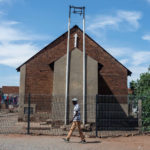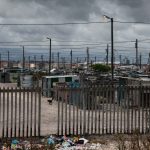Blikkiesdorp swansong: Breaking ground
The third of a three-part series on the past, present and uncertain future of Blikkiesdorp, a fissured Cape Town community in the embattled final throes of its lifespan.
Author:
14 December 2018

In the aftermath of the violent wave of vigilantism that killed as many as five Blikkiesdorp residents in August and September, and saw scores of shacks razed to the ground in early October, 56-year-old pastor Theodore Mxenge found himself in a precarious situation.
As things escalated to a tense and racialised standoff between residents, he felt compelled by his religious beliefs to intervene and attempt to broker peace between the two sides of the camp. But the lines between people identifying as coloured and Xhosa had been starkly drawn. Whenever he spoke to coloured residents, even those he considered friends, he said he now risked being labelled “impimpi” (an informer) by his fellow Xhosas.
At the same time, he told me he “could not deny” that he probably knew the vigilantes who had murdered members of the YGB gang and attacked their friends and relatives. He admitted they were likely among a group of residents he himself had sometimes joined on neighbourhood watch patrols over the past couple of months, which he said were initially prompted by the rape of a woman by gang members.
Two young men had been arrested in connection with one of the mob justice killings, that of Tashrieq Johnson, but the pastor maintained that at least one of them was innocent. Mxenge had helped lead an effort to collect R20 donations from the community to pay R2 000 bail at a recent bail hearing on 6 December (the suspects, whose bail conditions stipulate that they must stay out of Blikkiesdorp, are due to stand trial on 6 February 2019). But now there were rumours among a number of coloured residents that the collections were a cover for an extortion racket.
Compounding the pastor’s plight, the new Blikkiesdorp Joint Committee (BJC), of which Mxenge was part, ordered him to expel his own 19-year-old eldest son, a tik user and part-time dealer for the Young Gifted Bastards (YGB), from the camp. After some tough negotiations, he had dutifully done so. “It was very hard for me,” he said.

‘Spiritual journey’
But Mxenge insisted that all of his recent trials and tribulations were, ultimately, part of his “spiritual journey” and all for the greater good. “For now, things are calm at least. They are better,” he said.
The pastor, who has thinning hair, a greying goatee and a boyish smile, first moved to Blikkiesdorp in 2013 after running into financial difficulties and being evicted from a house in Grassy Park, also on the Cape Flats.
“When I first arrived here, it was very disorientating. When I was walking home one day I got lost trying to find my shack. The shacks all looked the same to me,” he told me when we met in a small, stuffy room at the back of the main evangelical church in Blikkiesdorp last month.
“My son wouldn’t tell his friends where we were living,” he added. “He was ashamed. I think he was not that strong. He was deeply affected by the situation. That’s when he started smoking tik.”
Mxenge’s family had been among a growing number of Xhosa-speaking South Africans to move to Blikkiesdorp in the past five years, mirroring trends increasingly seen across the Cape Flats, as the unemployment rate in the Eastern Cape nears 50% and people search for opportunity elsewhere.
In Blikkiesdorp, which, due to its impending closure is no longer supposed to be accepting new residents, Mxenge says that the significant demographic shift has been precipitated by departing residents illegally selling or renting their shacks to backyard dwellers in surrounding townships and shack settlements. Xolani Ndongeni, the local ward councillor, insisted that when this occurs, it is reported to local law enforcement and the relevant shacks are demolished. But a number of residents told me this was not always the case.
According to Jerome Daniels, the BJC chairperson, about 25 families are due to move out of Blikkiesdorp in the next few months, bound for new RDP houses in The Hague, an area of Delft, located about 2 kilometres from Blikkiesdorp.
Related article:
Adnan Lakay, a 50-year-old local imam with a lean, handsome face and an effortlessly relaxed demeanour, was among those slated for imminent departure with his wife and two young children. He estimated that as many as 400 families had already left Blikkiesdorp in the past year or so. (The Western Cape department of human settlements did not respond to multiple requests for comment on this report.)
Lakay said he’d initially been told his family would be out in early November but the move has been postponed to January 2019. “We’ve been waiting 10 or almost 11 years now, so what’s another month or two?” he said with a shrug of the shoulders, his voice betraying a hint of tired frustration.
Lakay grew up in Salt River. He moved to Durban for a short spell in his late teens to further his Islamic studies and had a brief but illustrious career as both a cricket and soccer player before moving back to Salt River and becoming a local SAPS officer.
In 2004, he was sent to prison for manslaughter. After a drawn-out car chase with two local gangsters that ended in a dark cul de sac, he’d shot and killed one of them as they got out of the car. “I’ll be honest, it felt right at the time,” he told me. “That guy had killed so many people that we knew of, but we just didn’t seem to be able to pin anything on him. We kept arresting him, then he’d be back on the street the next day.”
In prison, Lakay said he had become “affiliated” with the Number 27. “You don’t want to be kicked around, you just want peace of mind. Once you’re inside, your main worry is when do I get out, how do I get out, what I am going to do when I get out, how am I going to piece my life together again. So I just wanted to make sure I was left alone to think about those things.”

Futility sets in
When Lakay came out of prison and moved to Blikkiesdorp in 2009, an uncle convinced him to use his sharp intellect and his knowledge of Islam (he knows the entire Quran by heart) for his own rehabilitation and for that of other residents. “He said to me, ‘you have this knowledge, and there are people here that are hungry for that knowledge, you must do something with it,’” Lakay told me.
Since then, Lakay has been responsible for officiating most of the Islamic burials that involved Blikkiesdorp’s Muslim residents, as well as teaching the Quran to a number of younger locals. “There’s a lot of kids walking around Blikkiesdorp that I taught,” he said.
But he admitted that in recent months, with everything else that had happened in the camp, he’d begun to lose impetus. There was now a nagging sense of futility in his work. Many of those he had taught had ultimately been consumed by drugs or gangsterism, and a number of them had now been driven out of the camp. “It’s not a good feeling,” he said.
Related article:
Despite the creeping despondency he now felt in Blikkiesdorp, Lakay expressed mixed feelings about leaving. He went so far as to liken the camp to the famously vibrant community of District 6, which was decimated by the Group Areas Act during apartheid. “Believe it or not, people will have a lot of great memories about this place. For it to have an ending like this, with all this violence, it’s really sad. But I still believe that eventually we’ll be able to sit back and laugh about it all,” he said.
While many residents I spoke to over the course of the past two months expressed similarly conflicted feelings about leaving Blikkiesdorp, Jerome Daniels felt no such nostalgia. “When I put foot out of that gate for the last time and I look back, I don’t want to see Blikkiesdorp. Wherever we move, there must be nothing left here. It must all be gone. I don’t want to be reminded of this place, of all the hardships we experienced. I just want to look forward and see a brighter place,” he said.
Bloody final chapter
Lakay warned that there would likely be more race-based violence to come in Blikkiesdorp’s final chapters. He claimed that a coloured resident had been stabbed in his home by Xhosa patrollers as recently as early November, and that members of the YGB were loitering just outside the camp, robbing residents as they came and went. He said there were fears that over the festive season, when many of the Xhosa residents return to Eastern Cape, the YGB would try to wrest control of the camp.
“It might all seem safe and quiet, but things are actually very tense. We’re on the brink of civil war here,” he told me. “We don’t know what to expect in the coming weeks.”
But there would be moments of joy, too. On a balmy Wednesday morning in mid-November, Lakay was among a group of residents who gathered to bid farewell to pastor Mxenge’s 93-year-old mother, Nonceba Mxenge, Blikkiesdorp’s oldest resident. After being on the housing list since 1997, she was finally moving into her own home, one of the new RDP houses in The Hague, along with the pastor’s eldest son.
“Many have died here waiting for that moment,” Lakay told me.
Related article:
The following afternoon, I drove pastor Mxenge to his mother’s house to deliver a cooked meal – the pastor said he’d been informed that the electricity would only be connected in another six months so, in the meantime, this would be a daily trip for him.
Nonceba, sitting on a plastic chair in a still bare front room, smiled warmly as we entered her new home. “This is my house,” she said. “No one can tell me what to do or where to go any more.”
The pastor would sit with her for a while, then take a long, slow walk back to Blikkiesdorp.
This is the third of a three-part series on the past, present and uncertain future of Blikkiesdorp, a fissured Cape Town community in the embattled final throes of its lifespan.
Part one:
Part two:
Additional reporting by Shaun Swingler





